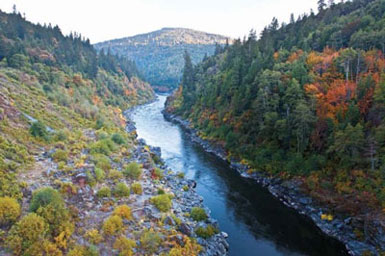California raked in $1 billion in its first cap-and-trade auction of the year, and since they take place every quarter, it can look forward to raising about $4 billion this year.
December’s auction brought in $400 million, so why so much more now? As of January 1, transportation fuels are included in the program.
This is a big deal. Until now, the program applied to a few hundred major stationary polluters – utilities, manufacturers and food processors. Now, it includes mobile sources – transportation fuels – which accounts for 40% of California’s emissions, expanding it dramatically.
Refineries and fuel wholesalers have to pay for emissions tied to fuel sales. They passed the cost to motorists, raising gas prices about 10 cents a gallon at the pump.
Even with the number of permits raised substantially, prices held steady at $12.21 per carbon credit, which gives companies the right to emit 1 ton of carbon this year.
Last year, Quebec joined the program, so the province will get a share. When Quebec on board the program became the Western Climate Initiative.
Carbon Offsets Protect Forests, Help Native Americans
As part of the carbon trading program, companies can cover up to 8% of emissions with purchases of less expensive carbon offsets.
Offsets can be used for three purposes:
- to pay businesses that destroy carbon-forcing HFCs like refrigerants;
- to pay dairies that capture methane
- to pay landowners that make a 100-year commitment to manage forests so they absorb maximum carbon from the atmosphere.
In April, California’s Air Resources Board (ARB) issued the Yurok tribe over 800,000 offset credits in one of the first approved forestry projects. At the going rate of about $9 a credit, the tribe earns several million dollars to protect its forests, reports the LA Times.

About half the land on its reservation is owned by logging companies and the tribe is using the proceeds to buy and restore its ancestral land along the northern California coast.
"Due to the heavy logging activity that occurred around the Blue Creek Drainage, there’s been significant degradation of habitat as well as fish population, by 80-90% from what it had been historically. We wanted to restore this land to its fullest capacity and the revenue from the carbon market offsets allowed us to do that," Vice Chair Susan Masten, told the Environmental Defense Fund.
Carbon projects allow the tribe to "maximize both revenue and the ability to preserve the forest," Chairman Thomas O’Rourke Sr., told the LA Times. It’s allows us to "do our part on global warming and to preserve our way of life so that our future generations can see the pristine forest that our parents’ grandparents saw."
Round Valley Indian Tribes is getting over 540,000 offset credits for its Improved Forest Management Project – 5,550 acres on its northern California reservation.
"This reinforces our goal of sustainable forestry to maintain levels of wildlife, native plants, fish, clean water, and reduced fire threats. This project also is in line with the tribes’ mission to ensure that our future generations enjoy the benefits of a healthy forest," Joe Dukepoo, Round Valley Tribal Councilman, told Indian Country Today.
ARB set up the program with rigorous rules to make sure that emissions reductions are "real, permanent, quantifiable, verifiable and enforceable." A 113-page protocol for forest projects shows how to measure the amount of carbon plants are absorbing, and requires extensive monitoring, reporting and independent verification.
Read our article, How California Will Spend the $5 Billion a Year From Cap-and-Trade.

 Loading...
Loading...
It is incorrect to imply that California will have $1B to spend as a result of this month’s carbon allowance auction.
The majority of that money (considerably more than half) is returned to utilities for the benefit of their customers (to avoid rate increases, for on-bill credits twice a year, etc.)
The remaining proceeds are split between California and our auction partner, the Canadian Province of Quebec. The amount of the actual total for California is also affected by the exchange rate at the time the total is tallied, and that has not yet happened.
Dave Clegern
Air Resources Board
Public Information Officer
for Climate Change Programs
dclegern@arb.ca.gov
A tax by any other name is still a tax.
I agree with William Abbott. This tax is just disguised as an increase in fuel costs. We wanted to use carbon credits in the Forest Service, however, the strict dis-allowance of any kind of harvest of trees would greatly increase wild fire threats. That doesn’t work for us, especially with the threat of worsening droughts from global warming. The refusal to acknowledge the threat of a huge amount of carbon being released from wildfire makes the forestry part of the carbon credit scheme almost useless.
From what I understand, sustainable forestry is required. That doesn’t prevent thinning the forest to prevent wildfires. And in terms of the tax, why do people so against it? In cap-and-trade, polluters are taxed to encourage them to clean up their act. The money raised is passed back to ratepayers and supports more energy efficiency and renewables in California.
tcknight did you try the “improved forest management” strategy? However, I suspect that this will only work once the forest has been burned….so not much help as I have found that thinning programs are very difficult to fund via any sort of improved management strategy by any of the carbon certification schemes.
Forget climate change for a minute. The long term goal should be sustainability, and carbon credits are a way to promote sustainable management and use of renewable materials and energy. If a company finds a way to use less energy to avoid the credit “tax”, their process just became more sustainable. If they source energy or materials that are sustainably managed…. Bingo, they just became more sustainable. As long as the rules don’t incentivize some strange unintended consequence, let’s see what happens.